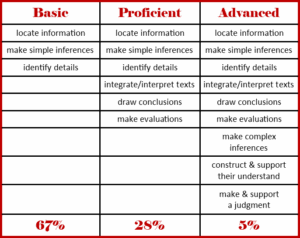How Important Is Reading Proficiency?
Is it possible that educators and parents don’t understand the importance of reading proficiency? Otherwise, why would they just accept that two-thirds of our fourth graders can’t achieve it? Parents would be alarmed if two-thirds of these children couldn’t operate a remote or ride a bicycle. Somehow, not being able to read proficiently doesn’t shake us up.
It’s obvious…we just don’t get it!
Every two years, the National Assessment for Educational Progress (NAEP) tests fourth graders and eighth graders in reading. Since 2009, in addition to numerical scores, the test administrators have provided labels for different levels of student reading achievement. These are “basic,” “proficient,” and “advanced.”
What is Reading Proficiency?
Perhaps the best way to describe reading proficiency is to see it in relation to the other two standards.
For example, students at the basic level of reading skill can locate information, make simple inferences, and identify details. Likewise, students at the proficient level of reading skill can also locate information, make simple inferences, and identify details. However, in addition, they can integrate and interpret texts and apply their understanding of the text to draw conclusions and make evaluations. Finally, advanced readers can do all of this plus make complex inferences, construct and support their understanding, and make and support a judgment.
Only about five percent of our fourth graders are advanced readers. Of the other ninety-five percent, roughly two-thirds are at the basic level. What is the difference between being a basic reader and a proficient reader? It’s being able to apply the information in the text. There’s quite a bit of difference between simply identifying details and being able to evaluate what was read.
 Why Is Reading Proficiency So Important?
Why Is Reading Proficiency So Important?
Everyone needs to be able to read with proficiency. Proficiency means reading with accuracy, speed, expression, and comprehension.
Reading proficiency is the cornerstone for academic success. Reading proficiency is the essential skill required for academic success, especially after the third grade. Students are expected to be proficient readers at the end of third grade, so reading instruction time is diminished or eliminated in favor of other disciplines.
From fourth grade on, most information is derived from written sources: textbooks, notes, online sites, etc. Consequently, any fourth-grade student who is not a proficient reader will struggle with lessons in literature, science and, history, for example. While they will be able to cite details in their texts, they may not be able to draw conclusions or evaluate the significance of what they are reading.
As these students move up in grade level, the amount of reading will increase, and the texts will be more complex. A student who is not a proficient reader will struggle in school and consistently fall behind. They will fall further behind each year, failing or barely passing. Some will react by acting out. Others will just give up and quit school. Either way, they will not achieve their potential.
What Must Be Done?
Anyone, regardless of age or reading level, can improve. The first step is in developing phonemic awareness. Phonemic awareness is the understanding of how the letters of a written word translate to the sounds of the spoken word. This is the process of reading.
However, reading scientists have concluded after decades of research, that there are five foundational skills required for becoming a proficient reader. Phonemic awareness is merely the first one. The other four are phonics, vocabulary, fluency, and comprehension.
Teachers and parents should recognize the impact of reading proficiency on academic achievement. Methods should be evaluated and modified to align with current research. Reading teachers should introduce phonics early and be prepared to set aside additional time for reading instruction for those who need it. Ultimately, we should all expect every fourth grader to be a proficient reader so they all have a shot at achieving their potential.
Why Phonics for Reading Proficiency?
Learning to read through structured phonics is, by far, the best way to learn to read because English words are primarily phonetic, about 85%. Thus, most words can be sounded out even if you have never seen them before. Phonics teaches you the sounds of English words, and you learn a set of rules that allows you to sound out or “sight-read” new words.
Letters and certain combinations of letters create predictable sets of speech sounds. It’s a sort of code. Once you have learned the phonetic “code,” you can figure out most new words. That’s how phonemic awareness works: a reader with phonemic awareness understands the code and can translate letters into their sounds.
Our Online Reading Lessons Are Free and Easy to Understand
Our program,7 Sound Steps to Reading is seven systematic, structured, and stepwise lessons, each one building on the one before. Each of the seven steps focuses on one or more of the foundation skills. The program is also self-paced and completely flexible for individualized learning. Every student can work at his or her own speed.
In fact, one of the biggest benefits of our program is the freedom to go at your own pace and move forward or backward as needed. Go forward and back at will to build greater skill and more solid foundations for the symbol/sound relationship. Plus, our program of 7 simple, structured, sound-oriented steps develops a firm foundation for phonemic awareness by the completion of Step 2, which makes phonemic awareness available to even a preschooler.
We are not suggesting the process is simple or quick, but they are free, easy to understand, and flexible for any level of reader. Every student can work at their own speed, and the lessons can be reviewed as many times as necessary.
Yes, it takes time and practice. However, at some point, it becomes automatic, like breathing! That's proficiency! How quickly can you achieve proficiency? It depends on where you started from and how quickly you can progress. Everyone is different, but everyone can improve their reading skills using 7 Sound Steps to Reading.
If you have questions, please email us at learn@soundenglish.org.



